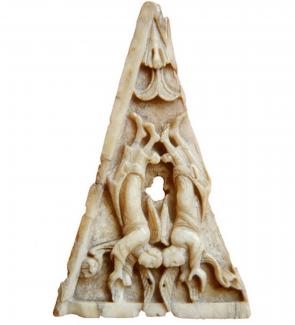Triangular ivory panel
Anglo-Saxon, second half of the 10th century AD
Found in the garden of "Landour", St Cross, Winchester, Hampshire
Carved in high relief on walrus ivory, this panel is a superb example of late Anglo-Saxon art of the Winchester School. The panel depicts two angels with outspread wings flying downwards, their hands lifted in adoration. A piece of drapery flutters over their nether arms. Above them, at the apex of the triangle, a leaf sprig uncurls from a triple acanthus spray. The surface is highly polished.
The ivory was probably mounted on the roof gable of a small house-shaped shrine. In this context, the paired adoring angels most probably accompanied a scene of crucifixion, baptism or Christ in Majesty. The angels are very similar to those found in two illuminated manuscripts produced in Winchester at this time; the Benedictional of St Ethelwold and the New Minster Charter. The expressive large hands of the ivory's angels are a particularly Anglo-Saxon feature which can be seen in many ivories and manuscripts of the later 10th and early 11th centuries, as are the curling flutters of the drapery and the stiff acanthus spray.



